Stonewall Jackson Statue
Introduction
Text-to-speech Audio
Images
Jackson statue at southeast corner of Capitol grounds.
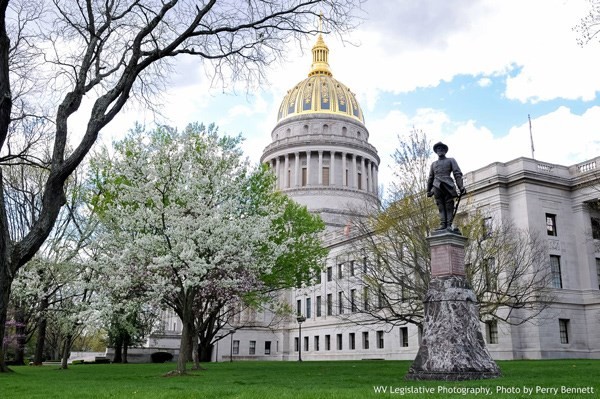
Statue inscription.
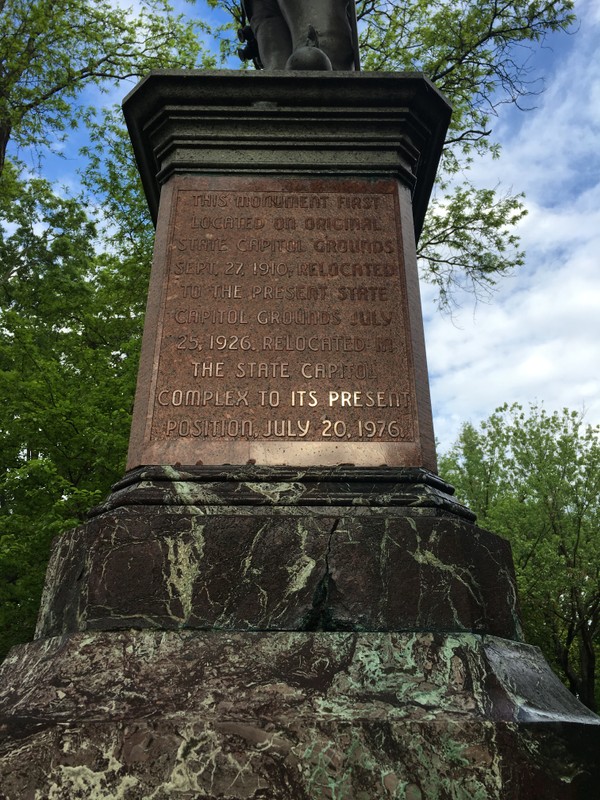
Young Thomas J. Jackson, 1846.
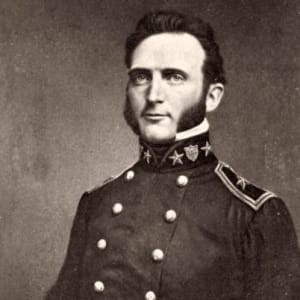
Thomas J. "Stonewall" Jackson, 1863.
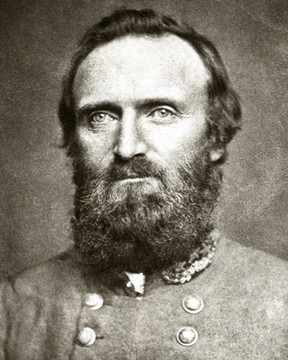
Photo from the 2017 protest.
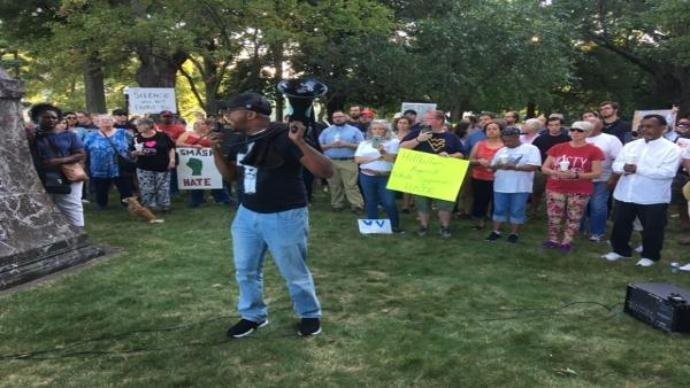
The Advocate, an African American newspaper published in Charleston West Virginia, demonstrated the connection between the monument's supporters and previous attempts to disfranchise Black voters and pass segregation laws in WV.
.jpg)
Backstory and Context
Text-to-speech Audio
Thomas Jonathan “Stonewall” Jackson emerged as one of the most well-known and skilled Confederate generals during the American Civil War. Yet Jackson hailed from humble roots. He was born on January 20, 1824, in Clarksburg, Virginia (now West Virginia). In his youth, he faced not only the death of his father but had to be given up by his impoverished mother to his firm uncle, who raised him on the Jackson estate near Weston. He grew into a shy and reserved man in an unloving household with his uncle at the helm. Still, this equanimity would play to his benefit once he entered the West Point U.S. Military Academy in 1842 and graduated 17th in his class of 59 cadets. Jackson was a large man for his time, six-foot tall and 175 pounds, and he possessed skill in mathematics. For this reason, Jackson was assigned to an artillery unit. The young officer served in the Mexican War and gained three promotions during the conflict. During a siege of Mexico City, Jackson met Robert E. Lee for the first time. After the war, he retired from active military service and taught at Virginia Military Institute in Lexington, Virginia. VMI students found professor Jackson peculiar and some even played pranks on the instructor. While unpopular with students, he was known as a devout Presbyterian by his peers.
Jackson also owned six enslaved persons: Amy, Hetty, George, Cyrus, Albert, and Emma. Hetty, George, and Emma took Jackson’s last name after his death, and Albert is believed to have been manumitted. Jackson opined little on slavery, so scholars often turn to his religious views and actions. Jackson acknowledged the humanity of enslaved persons and supported religious instruction for all persons. He also viewed slavery as compatible with Christianity. Despite concerns from Lexington citizens, Jackson ran a Sunday school for enslaved persons. The future general clearly accepted the institution of slavery and fought for its preservation during the Civil War.
In 1861, in the wake of Virginia’s secession, Jackson offered his services to the Confederacy and soon found himself back on the battlefield. On July 21, 1861, during the first major land battle of the Civil War at Manassas, Jackson played a pivotal role in securing Confederate victory. He earned himself the sobriquet “Stonewall” for his clear and decisive resolve. Throughout the first two years of the Civil War, Jackson proved himself a skilled, confident, and aggressive commander. A well-respected disciplinarian, Jackson rose to further prominence during the 1862 Shenandoah Valley Campaign. Jackson’s forces (dubbed “foot cavalry”) marched more than 650 miles, winning a string of battles along the way. Jackson became a corps commander in the Confederate Army of Northern Virginia and was Robert E. Lee’s “right hand” man. He led the Second Corps through many engagements, including the Seven Days, Cedar Mountain, Second Manassas, Antietam, and Fredericksburg.
Jackson’s career was cut short, however. On May 2, 1863, Jackson enjoyed arguably the best day of his military career as he led an incredibly successful surprise flank attack against the Army of the Potomac at the Battle of Chancellorsville. Hoping to continue the attack into nightfall, Jackson rode ahead of his lines in the darkness and was accidentally wounded by his own men. Taken to the nearby plantation of Guinea Station, Jackson’s left arm was amputated. Compounded with a case of pneumonia, Jackson died on May 10, 1863, just a month prior to the establishment of West Virginia and two months before the Battle of Gettysburg. His final words were, “Let us cross over the river, and rest under the shade of the trees.”
Like several other Confederate leaders, Jackson’s legacy and fame only grew in the years following the Civil War. Although West Virginia stood firm to the Union during the Civil War, many West Virginians wanted to link Jackson to his home state. In 1909, the Charleston Chapter of the United Daughters of the Confederacy gained permission to construct a monument to Jackson on the state capitol grounds at their expense; it was the first statue on capitol grounds. The bronze statue was cast in Italy by Moses Jacob Ezekiel, a Jewish-American who attended VMI and knew Jackson from his days there. Ezekiel was also a Confederate veteran.
The Jackson statue was unveiled on September 27, 1910, to much fanfare. The city celebrated with a parade, an event attended by 5,000 people. Several members of the United Confederate Veterans spoke, and many UDC members were on hand.
The unveiling ceremony revealed the connection between Confederate iconography and Jim Crow politics. Hundreds of the attendees, including former veterans, wore "Lily White" campaign buttons. In the early 1900s, supporters of this ideology sought to disenfranchise African American voters. The Lily White movement was less prevalent in West Virginia, but in 1908, the state's Democratic Party ran on a Lily White platform. Charleston Advocate publisher John Gilmer penned a lengthy article two weeks following the monument's dedication that drew a clear line between the reappearance of "Lilly White" buttons and race. This monument was not simply a reminder of an effective West Virginia military leader, Gilmer's article demonstrated, but a reminder of the connection between celebrations of the antebellum South and attempts to recreate a society based on white supremacy. Perhaps recognizing that this was nothing new to readers of the Advocate, an African American newspaper, most of Gilmer's article centered on the state Democratic Party's internal debate over whether to support Charleston Gazette editor George Byrne's attempt to incorporate segregation and disenfranchisement into the state's Democratic platform in 1910.
West Virginia Democrats ultimately decided against incorporating disenfranchisement and segregation into their 1910 platform. Gilmer pointed out that this was not the result of a change of heart, but rather a tactical decision. In close elections, the 15,000 Black voters in West Virginia might be a deciding factor, Gilmer reminded his readers. While they might not vote Democratic in an era when Southern Democrats openly embraced white supremacy, they might be less likely to cast their votes for a Republican Party that often took their support for granted if the Democrats toned down their rhetoric. Gilmer and other African Americans in the state were often critical of the Republican Party, and in 1912 Gilmer supported the Progressive Party and its leader, former Republican Teddy Roosevelt.
Recognizing that Black voters in West Virginia were not a monolithic block for the Republicans, the reemergence of Lily White buttons at the Jackson monument unveiling dismayed some Democrats as the party was making small inroads among Black voters. In the weeks that followed, Democratic leaders disavowed their support of the Lilly White campaign in hopes of rebuilding support among the few Black Democratic clubs in the state. Meanwhile, Gilmer wrote that white Republican politicians were "happy" to see the buttons reappear at the monument's dedication as it might increase Black support for the GOP. Beyond these political calculations, the outward support for a campaign based on segregation and disenfranchisement offers another example of how Confederate monument dedication ceremonies provided an outlet for these ideas.
The statue of Jackson was moved to its current location after the original Capitol building burned in 1921. A metal replica of the statue stands in the Virginia Military Institute in Lexington, Virginia. In recent years, the statue’s existence on capitol grounds has drawn increased protest. After the 2017 "Unite the Right" rally in Charlottesville, Virginia, about 150 West Virginians gathered around the Jackson statue and called for the monument's removal. The protestors held a vigil for the victims in Charlottesville and called for the removal of the Jackson statue, arguing that it is inappropriate to honor Confederate soldiers at the state’s capital.
On June 20, 2019, the 156th anniversary of West Virginia's admission into the Union as a new state, Charleston native Howard Swint stood in front of the Confederate statue and called for its removal citing it as a symbol of hate speech and white supremacy. Swint said other Confederate statues should be removed, as well. Swint suggested the statue be moved to a dark corner of the West Virginia State Museum in the Culture Center and the "12 Years a Slave" film should play in the background to highlight what the Confederacy fought for. He said the statue doesn't represent West Virginian values and those who erected Confederate monuments wanted to divide the nation.
In 2020, in the wake of nationwide protests over the killing of George Floyd, there were renewed calls for the monument’s removal; one petition demanding its removal gathered over 3,400 signatures. Governor Jim Justice stated, “From the standpoint of my personal beliefs, I don't feel like — that — anyone should feel uncomfortable here. This is our capital. This is our state. This is our people.”1 Ultimately, the statute’s fate rests with the state legislature. As of January 2021, the statue remains in situ on capitol grounds while Republican leaders who control a supermajority consider a bill that would bar the removal of statues on public grounds.
Cite This Entry
WV State University et. al. "Stonewall Jackson Statue." Clio: Your Guide to History. March 15, 2021. Accessed April 29, 2025. https://theclio.com/tour/1596/65
Sources
"Leaders Hopeless," Charleston Advocate, Charleston West Virginia, October 13, 1910.
"Calls to remove Confederate statue taken to the W.Va." Capitol. WSAZ News Channel 3. June 20, 2019. Accessed June 23, 2019. https://www.wsaz.com/content/news/Charleston-gathering-to-call-for-removal-of-Stonewall-Jackson-statue-at-WVa-Capitol-440190913.html.
Conner, Albert Z. "Moses Jacob Ezekiel: From Confederate Cadet to World-Famous Artist." Jewish-American History Foundation. Web. http://www.jewish-history.com/civilwar/moses_ezekiel.html
Flatley, Jake. "Charleston native calls for removal of Stonewall Jackson statue; 'It’s hate speech'." WV MetroNews. June 20, 2019. Accessed June 23, 2019. http://wvmetronews.com/2019/06/20/charleston-native-calls-for-removal-of-stonewall-jackson-statue-its-hate-speech/.
"George Byrne Reveals Plan And Recalls the Pledge of Democracy to Disfranchise the Negroes." Clarksburg Weekly Telegram. October 13, 1910. Web. Accessed June 25, 2020 via Chronicling America. https://chroniclingamerica.loc.gov/lccn/sn84037844/1910-10-13/ed-1/seq-8/
History.com Editors. Famed Confederate General Thomas J. "Stonewall" Jackson Dies, History . July 27th 2019. Accessed March 10th 2020. https://www.history.com/this-day-in-history/thomas-j-stonewall-jackson-dies.
History.com Editors. Shenandoah Valley Campaigns , History. August 21st 2018. Accessed March 10th 2020. https://www.history.com/topics/american-civil-war/shenandoah-valley-campaigns.
Jackson's 1862 Valley Campaign, Shenandoah Valley Battlefields . June 2nd 2015. Accessed March 10th 2020. https://www.shenandoahatwar.org/history/jacksons-1862-valley-campaign/.
"Justice has no plans to remove Jackson statue." Williamson Daily News. August 22, 2017. Accessed June 23, 2019. https://www.williamsondailynews.com/news/justice-has-no-plans-to-remove-jackson-statue/article_dc8e2ffe-67a9-52ad-88a3-92c46b5341da.html.
Knadler, Jessie. New Research Sheds Light on Slaves Owned by Stonewall Jackson, Radio IQ wvtf. May 15th 2018. Accessed March 10th 2020. https://www.wvtf.org/post/new-research-sheds-light-slaves-owned-stonewall-jackson#stream/0.
Lewis, Joshua. "Stonewall Jackson statue in Charleston draws criticism." June 6, 2020. WCHS ABC. Web. Accessed June 26, 2020. https://wchstv.com/news/local/stonewall-jackson-statue-under-fire
McGee, Jatara. Calls to remove W.Va. Confederate statue in wake of Va. unrest. WSAZ. August 13, 2017. Accessed February 09, 2019. https://www.wsaz.com/content/news/Charleston-gathering-to-call-for-removal-of-Stonewall-Jackson-statue-at-WVa-Capitol-440190913.html.
1. Mistich, Dave. "West Virginia, Born out of the Civil War, Grapples with Confederate Monuments." NPR. West Virginia Public Broadcasting. June 20, 2020. Web. Accessed June 26, 2020. https://www.npr.org/2020/06/20/881017611/west-virginia-born-out-of-the-civil-war-grapples-with-confederate-monuments
"Monument for Stonewall Jackson." Calhoun Chronicle. June 7, 1910. Web. Accessed June 25, 2020 via Chronicling America. https://chroniclingamerica.loc.gov/lccn/sn85059591/1910-06-07/ed-1/seq-1/
Robertson Jr., James I.. Stonewall Jackson, The West Virginia Encyclopedia . December 7th 2015. Accessed March 10th 2020. https://www.wvencyclopedia.org/articles/948.
Steelhammer, Rick. Charleston’s Civil War soldier statues erected with private funds. Charleston Gazette-Mail. August 22, 2017. Accessed February 09, 2019. https://www.wvgazettemail.com/news/charleston-s-civil-war-soldier-statues-erected-with-private-funds/article_301056fc-a75d-5bb8-81a3-fd72b1c4015b.html.
"Unveiled is Monument of 'Stonewall' Jackson in the City of Charleston." Clarksburg Daily Telegram. September 27, 1910. Web. Accessed June 25, 2020 via Chronicling America. https://chroniclingamerica.loc.gov/lccn/sn85059715/1910-09-27/ed-1/seq-2/
Vandiver, Frank E. Mighty Stonewall. 1957. Reprint. College Station: Texas A&M University Press, 1988.
Wallace, Jim, A History of the West Virginia Capitol: The House of State. The History Press, 2012.
Bennett, Perry
Photo by Jodie Groves, edited by Billy Joe Peyton.
https://www.biography.com/military-figure/stonewall-jackson.
https://www.onthisday.com/people/stonewall-jackson.
The Advocate, Charleston WV, October 13, 1910

